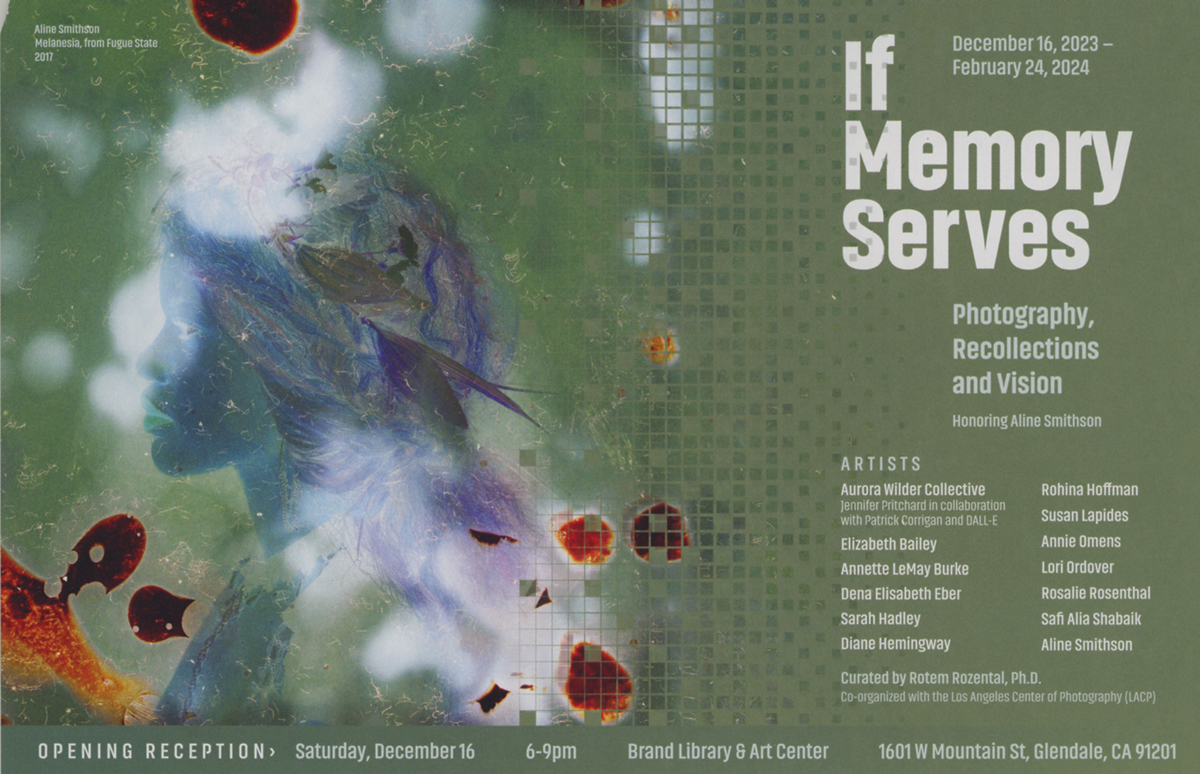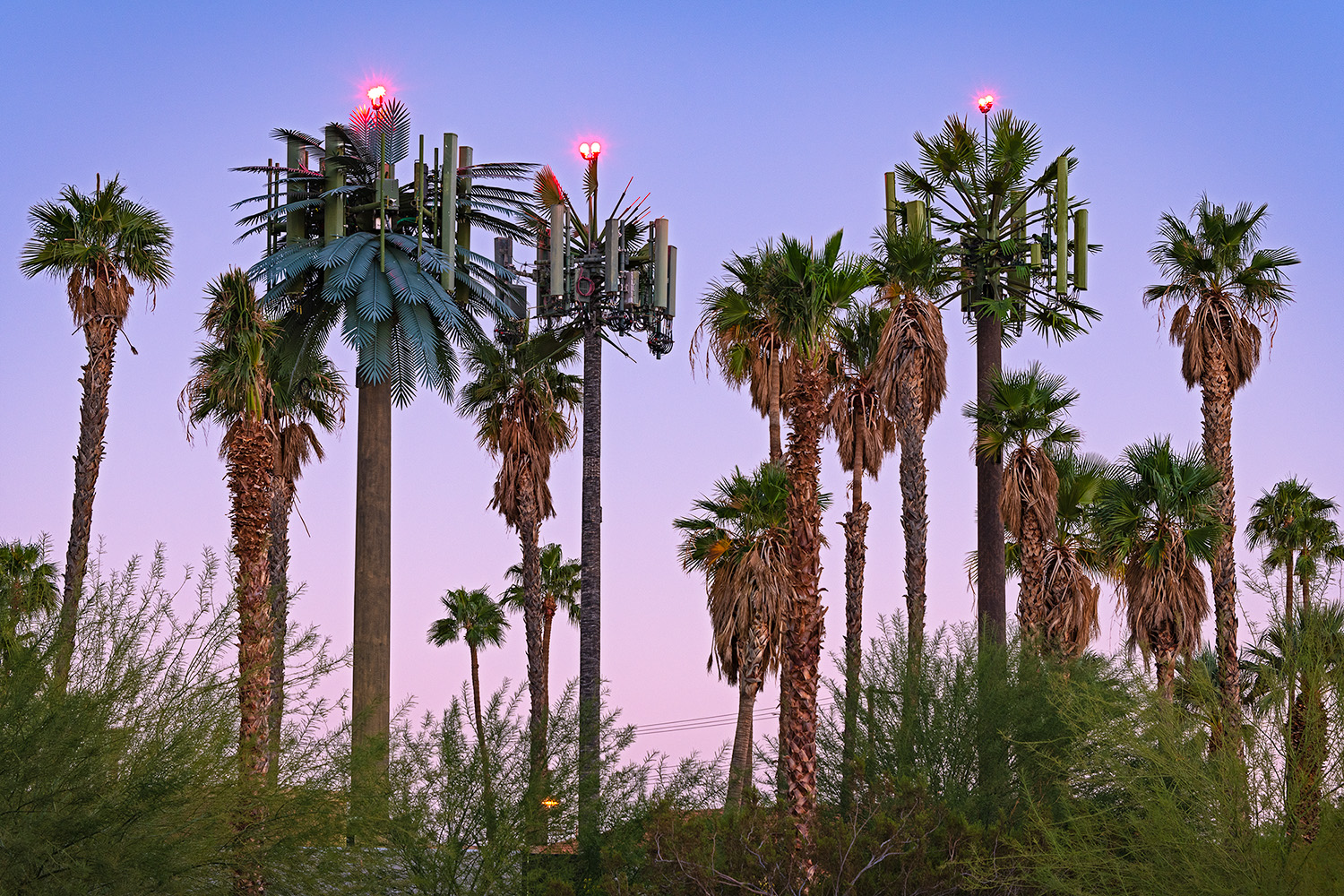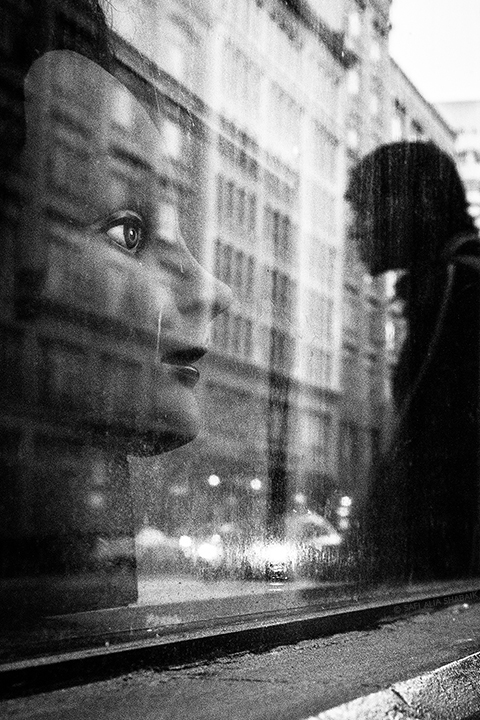If Memory Serves: Photography, Recollections and Vision
Tonight I open the biggest exhibition of my career. Today, however, I am giving a nod to the other artists in the exhibition, If Memory Serves: Photography Recollections and Visions hosted by The Los Angeles Center of Photography. In January, when I have my install photos, I’ll feature my part of the exhibition, The Ephemeral Archive. The event will take place at the Brand Library and Art Center, a very special venue in Glendale, CA.
When the LACP Executive Director and Curator, Rotem Rozental, approached me about having an exhibition that would be both the LACP Holiday party, but also recognize my 22 years of teaching with the organization, of course I said yes. She had also secured an enormous 5,000 sq foot venue and I realized that I could expand the exhibition to celebrate artists who I have have the privilege to mentor.
I never considered going into teaching, but I give all the credit for the push to the Founder of LACP, Julia Dean. I was terrified and worked hard to create curriculum that would help artists elevate and expand their practice. I also was determined to build a fine art photography community in Los Angeles that was supportive and inclusive. Decades later I am so honored to be part of a rich and robust community that works hard to shine a light on others, while pursuing their own practice. So here’s a toast to these wonderful artists and to the Los Angeles Center of Photography!
Curator Statement by Rotem Rozental
Our hard drives may fail. Our phones might break. We may forget an image that was once cemented in our minds. Our relationships with images and devices that hold our memories define how we understand our position in the world. If Memory Serves emerges from the moments those devices fail us, our recollections betray us and our pictures refuse to bring back the people they captured. This exhibition emerges from the intersection of our haunting pasts, possible futures, and our connections to photographic images, technologies and the systems that ask to speak for our photographs.
In 1986, Vilém Flusser regarded digital images as a “cultural revolution.” A decade later, Geoffrey Batchen predicted that the rise of digital computation systems will embody the demise of photography, since they collapse the indexical characteristics of images. In other words, digital images, created and produced through a computational device, do not have any outside and cannot point at or attest to the existence of anything other than themselves. Decades after their approaches began to inform global discourse, the digital photographic image had become embedded in technologies of communication, in how we understand our position in relations to others, in how we capture and share our lives. In fact, we live our lives for the benefit of the digital image. Not the singular being that is the digital image, but for the benefit of the entire system that holds, speaks and distributes photography.
The artists participating in this exhibition observe the complicated meeting points of photographic technologies, our haunting pasts, possible futures, and our relationships with the systems that capture our position in the world. If Memory Serves begins with Aline Smithson, a mentor, photographer and educator, whose work with artists had been redefining the field of photographic practice. This exhibition celebrates her immense contribution to photography and further comments upon the reach of her stewardship and pedagogy. The participating artists have all been studying with and from her. Seen together, their works offer profound insight into our co-existence with photography, suggesting pathways that connect personal experiences with larger societal issues and conflicts – from privacy to grief, to representation and immigration. How do we treat our most vulnerable community members? How do we remember those who have no one to commemorate them? How does our technology tears us apart? How can we claim a space to be seen and heard? How do we share our histories with the next generation? And what are we leaving behind for them?
In her work, Smithson frequently returns to moments of photographic loss — images corrupt by failing hard drives, pictures lost to their original owners, captions that were separated from their photographs – all driven by an acute awareness of the tactile relationships between photographs, memories and our connections with one another.
During the pandemic, Smithson led an online class at the Los Angeles Center of Photography, which brought together 11 women who realized their creative projects share a concern for issues surrounding photographic practice and the pains of loss, mortality and legacy, exacerbated by a moment defined by global trauma and uncertainty. That class birthed the group Memory is a Verb, who has been exhibiting together since 2021.
Their projects that are included here, alongside works by other former mentees, invite the viewers to immerse in transitions and transformations, in discomfort, in the borderlines between vision and sense, knowing and unknowing. At the same time, these works refuse nostalgia in its depoliticized condition. These projects are defined by the viewpoint and lived experiences of their creators: female identified, immigrants, descendants of inherited traumas, caregivers, providers. Photography is key to efforts to claim visibility, capture narratives and elicit conversations about the lives of vulnerable bodies and communities. The works on view can then be seen as opening points, a threshold, for a conversation that should never be silenced, a conversation that is as concerned about the conditions of its production – the possible futures of photography – as it is concerned with its political, social and personal content.
Annette LeMay Burke
@atelierlemay/
Fauxliage documents the proliferation of disguised cell phone towers in the American West. By attempting to conceal an unsightly yet essential technology of the modern world, our landscapes are now sown with a quirky mosaic of masquerading palms, evergreens, flagpoles, crosses, and cacti. But the towers are simulacra. They are water towers that hold no water, windmills that provide no power, and trees that provide no oxygen; yet they all provide five bars of service. I traveled to ten western states to photograph the variety of concealments. The towers pose the question: how much of an ersatz landscape and manufactured nature are we willing to accept in exchange for connectivity?
The faux trees pose an environmental concern. As they age, the plastic needles and fronds breakdown and litter the ground below. What started as an attempt to reduce visual pollution is now creating plastic pollution. I collected the varied leaf types and used them to create cyanotype contact prints — a nod to pioneering English botanist Anna Atkins who created a catalog of British algae in 1843 using the newly discovered cyanotype process. These photograms remind us of the arc of technology in photography, computing, and communication.
Annie Omens
@annie_omens/
Transcending the Temporal explores my connection with trees was an antidote for the loss of connection I felt with society during the pandemic and lockdown. Being in nature, amongst the trees, helped me transcend this temporal situation of suffering and death. The forest spoke to my soul of a kind of essential stability and permanence allowing me to see life cycle from seedling to fallen tree, renewing itself to support life again. The forest gave me the courage to re-member my place in the world and feel grounded in it.
Through the use of photomontage, I layered together two or more of my straight captures to create an ethereal sense of the ordinary. I reveal a mystical connection to something that is more permanent by dissolving boundaries, affirming the unseen relationship to something beautiful, larger and profound.
Dena Eber
@denaeber/
“Bere’shith” is the first Hebrew word in Genesis and means “in the beginning.” This work is my story of starting again after considerable loss in my life, which warranted a reflection on the larger meaning of cycles, death, and renewal. Coming through this pain and starting again on new land is what inspired this project.
In the Jewish tradition, we have a yearly cycle of reading the torah, starting over again each year from the beginning of the scroll, reading the same words. However, the text takes on new meaning as we evolve, thus reflecting the spiral variation of a cycle as we move forward in time. In short, the project investigates what it means to be human, to move through sadness, to start again, to create a new life, and to be alive.
The images reflect the symbolism of cycles that encompass reformation and transformation, just like the caterpillar digests its own body to restructure its DNA into a new organism. This tumultuous start transforms into something new, an ultimate peace in a new land (Exodus).
This work is my spiral, my renewal, and dare I say – heaven presented through light.
Diane Hemingway
@dianedhemingway/
The photographs and recorded prose in The Wild Cosmos chronicle my interior journey through life and profound loss. Even as an adult, nothing prepared me for when the stars–my mom, dad, and brother–fell from the sky. Seeking solace, I immersed myself in the land and in my art, trusting that my world would right itself.
Looking for light in the darkness, I retraced the cross-country trips of my youth and explored the backroads of Maine. I wanted to rekindle the wonder of my untethered childhood while remembering those I had lost.
Nature is a portal to survival. Much like the transcendentalists, I believe that it is essential to experience the simplicity and solitude of nature to better understand oneself. I emerged resilient like the wild cosmos, a wildflower that can thrive in almost any circumstance.
The images in The Wild Cosmos are grouped into categories from my experiences: loss, whimsy, wonder, and mysticism. I pair my photographs with audio versions of my writing loosely based on my journal of field notes and dreams. Both my photography and my recorded prose are love letters to places, memories, dreams and family. Each is an invitation to pay attention.
Elizabeth Bailey
@elizabeth_bailey01/
The House Next Door
When my reclusive neighbor of many years disappeared and died in her house, there were no friends or family to claim anything that remained: her body, her possessions, or even her memory. It seemed she was simply going to disappear.
Who had she been? What had happened to her? Convinced the answers lay inside her silent, vacant house, my curiosity grew into obsession.
“The House Next Door” documents the days and weeks and months that followed, as I gained entry, and returned to the house again and again. Through letters, photos, and personal items—many salvaged from a dumpster I climbed into—I pieced together fragments of her history. Her mementos grew meaningful to me, and I began spending more and more time in the house next door, giving shape and voice to her past.
As her story intertwined with my own, I felt both gratitude, and a deep sadness for all that was lost. In life I’d hardly known her, thinking our differences were insurmountable. Now I wondered; were we really so different, after all?
A meditation on atypical beauty, perception, and point of view, “The House Next Door” ultimately considers how one individual’s untold story can impact and alter the life of another.
Aurora Wilder [corrigan+pritchard]
@thisisaurorawilder
@patrick.s.corrigan
@jenniferpritchardstudio.com
Patrick and I placed An Ambiguous Place at the intersection of philosophy and metaphysics. Over a condensed timeframe, we set daily probing prompts for Dallé – anthropomorphized into a character in our story, exploring liminal topics in a collaboration of prompts and pictures, unearthing the In-between. At every juncture of this diaristic exploration, we were sliding between worlds -between human form and technology, pursuing individualized truths of our future selves and worlds in an innocent, unprejudiced childlike play state.
As Artists, we examined how it might further our understanding of the world and our influence within it by asking if AI is programmed by humans and modeled on the sum of human imagery, isn’t any work product a broader understanding of ourselves and a provocation for our shared future? At least in the onset, before the archives are populated with images not connected to reality or a narrative not based on human fact. There is legitimate concern and controversy over the acceleration of disinformation emerging from Artificial Intelligence and its capabilities. Perhaps, in the plethora of generated images, artistic endeavors can move beyond the photographic domain and explore other possibilities. AI can be the catalyst for new ways of seeing each other and the world.
We were encouraged by the knowledge that truth in photography has been debated since the 1800s, raising philosophical questions about the grammar of photography, memory, and reality. The presentation at Brand Library interprets a ‘singularity’ defined by Machine Learning expert Ray Kurzweil in 2005 – nearly twenty years ago – where humans and AI are merged to achieve one. Presented this way, the work evolves into something “other” – not human, not AI, altogether something else, a convergence of human and machine.
We have elected to hold the middle place, ambiguous by definition, parenthetically polarized by fear and the thrilling exploration of the unknown.
Lori Ordover
@lordover
Silence Is.
Unlike most chaotic and cacophonous childhoods, mine was spent in silence. Growing up with a deaf mother, I spent most of my youth not being heard. My project, Silence Is evokes my experience of her through self-portraits, family photographs and empty spaces.
My mother, now 90, reads lips and is quite good at it. At a young age she was taught to speak. She spoke with an accent, but most people didn’t realize she was deaf. She is laser focused on your mouth when in conversation.
A clue to her deafness would come when she would say an incorrect response during a conversation. Most people would assume that they did not understand, not that my mother did not hear what they were saying. Rarely would she ask someone to repeat themselves, fearing they may guess she is deaf.
I was not allowed to correct her misunderstandings publicly.
When she turns from you, you are gone, completely. When having an argument, she will say her piece, then turn away, giving you no chance to respond.
At times like this as a child, I felt powerless, invisible, and angry. At an early age I gave up trying to be heard, which left me spending a lot of time alone in my thoughts.
Rohina Hoffman
@rohinaphoto
In Gratitude is an homage to food and family. Created during the pandemic, it is a series of portraits of myself, my husband, and my three children showcasing the items that we use to create our daily meals. Despite the uncertainty and fear we feel because of the pandemic, it has enabled me to see my gratitude more clearly, allowing me to honor the foods we eat and the laborers who bring this bounty to market through these portraits. Influenced by Pablo Neruda’s Elemental Odes, I add my own poetry to celebrate the mundane and acknowledge the idea of scarcity. I aim to highlight the words of MFK Fisher “our three basic needs, for food, security and love, are so mixed and mingled and entwined, that we cannot straightly think about one without the others.”
Rosalie Rosenthal
@rosalierosenthal/
Midlife Tableaux
Midlife is traditionally a nexus for recalibration; parents reach an age of needing care, children become adults, and those of us in the middle assess and adapt. Midlife Tableaux is a manifestation of that reconsideration of self through examination of significant objects in my familial histories.
The project began after my father’s worsening Alzheimer’s disease caused my parents to move from their home. Objects were packed-up, and many made their way to me. I photographed these objects as an act of care and as an expression of agency as I witnessed the intractable grip of memory loss. I chose the visual language of the still life and vanitas traditions to provide the historical context to explore mortality and to consider the significance of possessions, once resplendent, but now outdated.
As my work progressed and the pandemic kept my family at home, I included myself and my daughter in the scenes. The intergenerational element allows the objects to become actors in a larger narrative about the gift and weight of a family legacy, both material and individual. Midlife Tableaux touches the human experiences of loss and transition and offers a respite for others to mine their interiority.
Safi Alia Shabaik
@flashbulbfloozy/
My interest in the human condition and relentless curiosity for people and things has led me on many adventures exploring and documenting daily life on city streets. To quote Robert Frank, “I’m always looking outside, trying to look inside. Trying to say something that is true. But maybe nothing is really true. Except what’s out there. And what’s out there is always changing.” My affair with the street began during my art school college years, inspired by the legacy of many street photographers – Diane Arbus, Robert Frank, Helen Levitt, Mary Ellen Mark, Susan Meiselas, Weegee, Garry Winogrand, etc. I have spent countless hours hitting the pavement with camera-in-hand to build my visual voice, hone my eye, strengthen my intuitive ability to anticipate human behavior, and capture life’s grand choreography as it unfolds in front of my lens. This is an ever-growing body of work chronicling daily life, ranging from 2015 to current day. It presents my version of truth, which is constantly evolving with the reinvention and revitalization of the city itself. This work has become my visual creative journal marking a deeper relationship with human existence and big city living, a dynamic for which I have gained a profound new respect and love.
Sarah Hadley
@sarahhadleystudio
The Whispering Dark
I had an unusual upbring that has transformed how I see the world, understand the past, and recognize how visual influences shape our art making. I grew up on the 4th floor of the Gardner Museum in Boston. My father was the museum director for 20 years and we lived in an Italian renaissance palace surrounded by magnificent art, antiques, and furniture. My brother and I played in large ivy walled gardens surrounded by sarcophagi and ancient sculptures.
Though she had been dead for over 50 years, Isabella Stewart Gardner was a constant spectral presence in my life, and her indelible influence and artistic vision permeated every corner of my world. As a young girl, I sought to find my place amidst classical female representations and architectural splendor.
My project, the Whispering Dark, reflects a series of layered narratives that speak to the enduring allure and influence of the past and revisit questions of home and belonging. Through the juxtaposition and fusion of images, I am plumbing my recollections of those formative years, spent prowling amidst such grandeur and in the deep shadows of the gardens. The work weaves an intricate tapestry between memory and imagination, and speaks to not only the legacy of a female visionary, but honors her profound impact on my artistic journey.
Susan Lapides
@susanlapides/
Screen Time
Cellphones are ubiquitous, and they have changed public spaces. As people turn away from each other and toward devices, phone interactions feel hidden and private; yet every online action is potentially public. We often share more about our private lives to strangers on social media than to those sitting beside us.
My photographic series “Screen Time” pairs a studio portrait with a reveal of the subject’s phone screen, showing their recent activity. How does this knowledge, which might reinforce or contradict an initial impression, influence our perception of an individual? What sorts of clues are hiding in the browser cache?
This series explores how the pervasive influence of technology impacts privacy, identity, and engagement with one another.
Posts on Lenscratch may not be reproduced without the permission of the Lenscratch staff and the photographer.
Recommended
-
Arnold Newman Prize: C. Rose Smith: Scenes of Self: Redressing PatriarchyNovember 24th, 2025
-
The Aline Smithson Next Generation Award: Emilene OrozcoNovember 21st, 2025
-
MATERNAL LEGACIES: OUR MOTHERS OURSELVES EXHIBITIONNovember 20th, 2025
-
Josh Aronson: Florida BoysNovember 1st, 2025
-
Robert Rauschenberg at Gemini G.E.LOctober 18th, 2025



























































